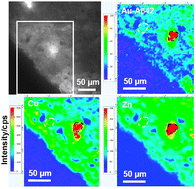The mechanism that triggers amyloid-β (Aβ) fibrillation and aggregation is still elusive. Evidence suggests that the extensional interactions of the amyloid precursor protein (APP) and Aβ with transition biometals, copper (Cu) and zinc (Zn), may be key occurrences in the processes of Aβ aggregation and toxicity. By using an immunogold labeling technique combined with synchrotron radiation X-ray fluorescence microprobe (SR-μXRF) scanning analysis, the profiles of APP, Aβ42 and Cu, Zn in the brain of APP transgenic mouse with the development of the disease were characterized. This investigation provides visual, kinetic and spatial evidence of the correlation of APP and Aβ-metals in AD brain sections. The visual evidence demonstrates the association of metals Cu and Zn with Aβ42 during plaque formation, which helps implicate the role of metal ion homeostasis in human AD pathology.
You have access to this article
 Please wait while we load your content...
Something went wrong. Try again?
Please wait while we load your content...
Something went wrong. Try again?


 Please wait while we load your content...
Please wait while we load your content...